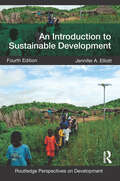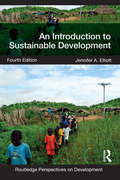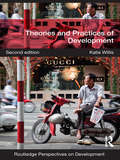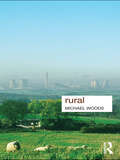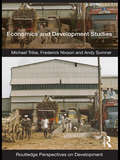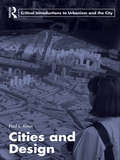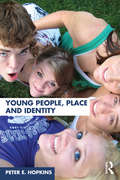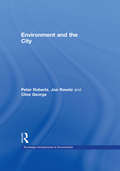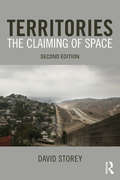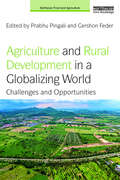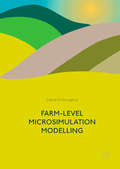- Table View
- List View
New Directions in Sustainable Design
by Adrian Parr Michael ZaretskyRecently there has been a plethora of work published on the topic of sustainability, much of which is purely theoretical or technical in its approach. More often than not these books fail to introduce readers to the larger challenge of what thinking sustainably might entail. Combining a series of well know authors in contemporary philosophy with established practitioners of sustainable design, this book develops a coherent theoretical framework for how theories of sustainability might engage with the growing practice of design. This book: brings together new and emerging perspectives on sustainability provides cohesive and jargon-free reading articulates the specificity of both theory and practice, to develop a symbiotic relationship which allows the reader to understand what thinking sustainably entails This volume describes a variety of new ways to approach sustainable design and it equips the next generation of designers with necessary conceptual tools for thinking sustainably.
An Introduction to Sustainable Development
by Jennifer ElliottThis fourth edition has been comprehensively rewritten and updated to provide a concise, well illustrated and accessible introduction to the characteristics, challenges and opportunities of sustainable development with particular reference to developing countries. The contested nature of sustainable development is explored through a detailed consideration of changing ideas and practices within environmentalism and development thinking. The text identifies the different actors involved (from institutions of global governance through to community based organisations), the policies and mechanisms through which sustainable development is being sought and considers the outcomes for particular groups and environments in both rural and urban contexts. ?? This edition places stronger emphasis on the global challenges of sustainable development with an understanding of inter-linked crises in climate, energy, economy, poverty and social injustice. It explores how these issues are leading to deep questioning of what sustainable development is, what it should be, and how sustainable development policies and mechanisms are being reconsidered. The book gives new consideration to the challenge of achieving lower carbon growth, climate adaptation, and the implications on sustainable development of rapidly expanding economies, including China and India. It contains greater discussion of how civil society movements influence outcomes of international climate policy, as well as technological developments in energy and agriculture. The text also contains a substantially expanded discussion of how poverty remains central to sustainable development challenges, as revealed through the Millennium Ecosystem Assessment and Millennium Development Goals. This invaluable text retains the core message that sustainable development has become central to debates about environment and development. Containing a substantial number of new boxed case studies, learning outcomes, chapter summaries, discussion questions, further reading and websites, this text provides an essential introduction for students.
An Introduction to Sustainable Development
by Jennifer ElliottThis fourth edition has been comprehensively rewritten and updated to provide a concise, well illustrated and accessible introduction to the characteristics, challenges and opportunities of sustainable development with particular reference to developing countries. The contested nature of sustainable development is explored through a detailed consideration of changing ideas and practices within environmentalism and development thinking. The text identifies the different actors involved (from institutions of global governance through to community based organisations), the policies and mechanisms through which sustainable development is being sought and considers the outcomes for particular groups and environments in both rural and urban contexts. ?? This edition places stronger emphasis on the global challenges of sustainable development with an understanding of inter-linked crises in climate, energy, economy, poverty and social injustice. It explores how these issues are leading to deep questioning of what sustainable development is, what it should be, and how sustainable development policies and mechanisms are being reconsidered. The book gives new consideration to the challenge of achieving lower carbon growth, climate adaptation, and the implications on sustainable development of rapidly expanding economies, including China and India. It contains greater discussion of how civil society movements influence outcomes of international climate policy, as well as technological developments in energy and agriculture. The text also contains a substantially expanded discussion of how poverty remains central to sustainable development challenges, as revealed through the Millennium Ecosystem Assessment and Millennium Development Goals. This invaluable text retains the core message that sustainable development has become central to debates about environment and development. Containing a substantial number of new boxed case studies, learning outcomes, chapter summaries, discussion questions, further reading and websites, this text provides an essential introduction for students.
Theories and Practices of Development
by Katie WillisGlobal economic crisis and the implications of global environmental change have led academics and policy-makers to consider how ‘development’ in all parts of the world should be achieved. However, ‘development’ has always been a contested idea. While often presented as a positive process to improve people’s lives, the potential negative dimensions of ‘development’ on people and environments must also be recognized. Theories and Practices of Development provides a clear and user-friendly introduction to the complex debates around how development has been understood and achieved. The second edition has been fully updated and expanded to reflect global political and economic shifts, as well as new approaches to development. The rise of China and India is given particular attention, as is the global economic crisis and its implications for development theories and practice. There are new sections on faith-based development, and the development dimensions of climate change, as well as greater engagement with development theories as they are put into practice in the Global North. The book deals with the evolution of development ideas and policies, focusing on economic, political, social, environmental and spatial dimensions. It highlights how development cannot be considered as a neutral concept, but is entwined with inequalities in power at local, as well as national and global scales. The use of boxed examples, tables and illustrations helps students understand complex theoretical ideas and also demonstrates how development theories are put into practice in the real world. Each chapter ends with a summary section, discussion topics, suggestions for further reading and website resources.
Rural (Key Ideas in Geography)
by Michael WoodsThe division of ‘rural’ and ‘urban’ is one of the oldest ideas in Geography and is deeply engrained in our culture. Throughout history, the rural has been attributed with many meanings: as a source of food and energy; as a pristine wilderness, or as a bucolic idyll; as a playground, or a place of escape; as a fragile space of nature, in need of protection; and as a primitive place, in need of modernization. But is the idea of the rural still relevant today? Rural provides an advanced introduction to the study of rural places and processes in Geography and related disciplines. Drawing extensively on the latest research in rural geography, this book explores the diverse meanings that have been attached to the rural, examines how ideas of the rural have been produced and reproduced, and investigates the influence of different ideas in shaping the social and economic structure of rural localities and the everyday lives of people who live, work or play in rural areas. This authoritative book contains case studies drawn from both the developed and developing world to introduce and illustrate conceptual ideas and approaches, as well as suggested further reading. Written in an engaging and lively style, Rural challenges the reader to think differently about the rural.
Conducting Research in Conservation: Social Science Methods and Practice
by Helen NewingConducting Research in Conservation is the first textbook on social science research methods written specifically for use in the expanding and increasingly multidisciplinary field of environmental conservation. The first section on planning a research project includes chapters on the need for social science research in conservation, defining a research topic, methodology, and sampling. Section two focuses on practical issues in carrying out fieldwork with local communities, from fieldwork preparation and data collection to the relationships between the researcher and the study community. Section three provides an in-depth focus on a range of social science methods including standard qualitative and quantitative methods such as participant observation, interviewing and questionnaires, and more advanced methods, such as ethnobiological methods for documenting local environmental knowledge and change, and participatory methods such as the ‘PRA’ toolbox. Section four then demonstrates how to analyze social science data qualitatively and quantitatively; and the final section outlines the writing-up process and what should happen after the end of the formal research project. This book is a comprehensive and accessible guide to social science research methods for students of conservation related subjects and practitioners trained in the natural sciences. It features practical worldwide examples of conservation-related research in different ecosystems such as forests; grasslands; marine and riverine systems; and farmland. Boxes provide definitions of key terms, practical tips, and brief narratives from students and practitioners describe the practical issues that they have faced in the field.
Conducting Research in Conservation: Social Science Methods and Practice
by Helen NewingConducting Research in Conservation is the first textbook on social science research methods written specifically for use in the expanding and increasingly multidisciplinary field of environmental conservation. The first section on planning a research project includes chapters on the need for social science research in conservation, defining a research topic, methodology, and sampling. Section two focuses on practical issues in carrying out fieldwork with local communities, from fieldwork preparation and data collection to the relationships between the researcher and the study community. Section three provides an in-depth focus on a range of social science methods including standard qualitative and quantitative methods such as participant observation, interviewing and questionnaires, and more advanced methods, such as ethnobiological methods for documenting local environmental knowledge and change, and participatory methods such as the ‘PRA’ toolbox. Section four then demonstrates how to analyze social science data qualitatively and quantitatively; and the final section outlines the writing-up process and what should happen after the end of the formal research project. This book is a comprehensive and accessible guide to social science research methods for students of conservation related subjects and practitioners trained in the natural sciences. It features practical worldwide examples of conservation-related research in different ecosystems such as forests; grasslands; marine and riverine systems; and farmland. Boxes provide definitions of key terms, practical tips, and brief narratives from students and practitioners describe the practical issues that they have faced in the field.
Economics and Development Studies
by Michael Tribe Frederick Nixson Andy SumnerDevelopment studies textbooks and courses have sometimes tended to avoid significant economic content. However, without an understanding of the economic aspects of international development many of the more complex issues cannot be fully comprehended. Economics and Development Studies makes the economic dimension of discourse around controversial issues in international development accessible to second and third year undergraduate students working towards degrees in development studies. Following an introductory chapter outlining the connections between development economics and development studies, this book consists of eight substantive chapters dealing with the nature of development economics, economic growth and structural change, economic growth and developing countries, economic growth and economic development since 1960, the global economy and the Third World, developing countries and international trade, economics and development policy, and poverty, equality and development economists, with a tenth concluding chapter. This book synthesizes existing development economics literature in order to identify the salient issues and controversies and make them accessible and understandable. The concern is to distinguish differences within the economics profession, and between economists and non-economists, so that the reader can make informed judgments about the sources of these differences, and about their impact on policy analysis and policy advice. The book features explanatory text boxes, tables and diagrams, suggestions for further reading, and a listing of the economic concepts used in the chapters.
Economics and Development Studies
by Michael Tribe Frederick Nixson Andy SumnerDevelopment studies textbooks and courses have sometimes tended to avoid significant economic content. However, without an understanding of the economic aspects of international development many of the more complex issues cannot be fully comprehended. Economics and Development Studies makes the economic dimension of discourse around controversial issues in international development accessible to second and third year undergraduate students working towards degrees in development studies. Following an introductory chapter outlining the connections between development economics and development studies, this book consists of eight substantive chapters dealing with the nature of development economics, economic growth and structural change, economic growth and developing countries, economic growth and economic development since 1960, the global economy and the Third World, developing countries and international trade, economics and development policy, and poverty, equality and development economists, with a tenth concluding chapter. This book synthesizes existing development economics literature in order to identify the salient issues and controversies and make them accessible and understandable. The concern is to distinguish differences within the economics profession, and between economists and non-economists, so that the reader can make informed judgments about the sources of these differences, and about their impact on policy analysis and policy advice. The book features explanatory text boxes, tables and diagrams, suggestions for further reading, and a listing of the economic concepts used in the chapters.
Cities and Design
by Paul L. KnoxCities, initially a product of the manufacturing era, have been thoroughly remade in the image of consumer society. Competitive spending among affluent households has intensified the importance of style and design at every scale and design professions have grown in size and importance, reflecting distinctive geographies and locating disproportionately in cities most intimately connected with global systems of key business services. Meanwhile, many observers still believe good design can make positive contributions to people’s lives. Cities and Design explores the complex relationships between design and urban environments. It traces the intellectual roots of urban design, presents a critical appraisal of the imprint and effectiveness of design professions in shaping urban environments, examines the role of design in the material culture of contemporary cities, and explores the complex linkages among designers, producers and distributors in contemporary cities, for example: fashion and graphic design in New York; architecture, fashion and publishing in London; furniture, industrial design, interior design and fashion in Milan; haute couture in Paris and so on. This book offers a distinctive social science perspective on the economic and cultural context of design in contemporary cities, presenting cities themselves as settings for design, design services and the ‘affect’ associated with design.
Cities and Design
by Paul L. KnoxCities, initially a product of the manufacturing era, have been thoroughly remade in the image of consumer society. Competitive spending among affluent households has intensified the importance of style and design at every scale and design professions have grown in size and importance, reflecting distinctive geographies and locating disproportionately in cities most intimately connected with global systems of key business services. Meanwhile, many observers still believe good design can make positive contributions to people’s lives. Cities and Design explores the complex relationships between design and urban environments. It traces the intellectual roots of urban design, presents a critical appraisal of the imprint and effectiveness of design professions in shaping urban environments, examines the role of design in the material culture of contemporary cities, and explores the complex linkages among designers, producers and distributors in contemporary cities, for example: fashion and graphic design in New York; architecture, fashion and publishing in London; furniture, industrial design, interior design and fashion in Milan; haute couture in Paris and so on. This book offers a distinctive social science perspective on the economic and cultural context of design in contemporary cities, presenting cities themselves as settings for design, design services and the ‘affect’ associated with design.
Young People, Place and Identity
by Peter E. HopkinsYoung People, Place and Identity offers a series of rich insights into young people’s everyday lives. What places do young people engage with on a daily basis? How do they use these places? How do their identities influence these contexts? By working through common-sense understandings of young people’s behaviours and the places they occupy, the author seeks to answer these and other questions. In doing so the book challenges and re-shapes understandings of young people’s relationships with different places and identities. The textbook is one of the first books to map out the scales, themes and sites engaged with by young people on a daily basis as they construct their multiple identities. The scales explored here include the body, neighbourhood and community, mobilities and transitions and urban-rural settings and how these all shape and are shaped by young people’s identities. Each chapter explores how social identities (such as race, gender, sexuality, class, disability and religion) are constructed within particular contexts and influenced by multiple processes of inclusion and exclusion. These discussions are supported by details of the research methods and ethical issues involved in researching young people’s lives. Drawing upon research from a range of contexts, including Europe, North America and Australasia, this book demonstrates the complex ways in which young people creatively shape, contest and resist their engagements with different places and identities. The range of issues, topics and case studies explored include: ethical and methodological issues in youth research; youth subcultures; experiences of home; territorialism; youth and crime; political engagement and participation; responses to global issues; engagements with different institutional contexts; negotiating public space; the transition to adulthood; drinking cultures. The author explores these issues through blending together original empirical research, theory and policy. Individual chapters are supported by key themes, project ideas and suggested further reading. Details of key authors, journals and research centres and organisations are also included at the end of the book. This textbook will be pertinent for undergraduate and postgraduate students and academic researchers interested in better understanding the relationships between young people, places and identities.
Young People, Place and Identity
by Peter E. HopkinsYoung People, Place and Identity offers a series of rich insights into young people’s everyday lives. What places do young people engage with on a daily basis? How do they use these places? How do their identities influence these contexts? By working through common-sense understandings of young people’s behaviours and the places they occupy, the author seeks to answer these and other questions. In doing so the book challenges and re-shapes understandings of young people’s relationships with different places and identities. The textbook is one of the first books to map out the scales, themes and sites engaged with by young people on a daily basis as they construct their multiple identities. The scales explored here include the body, neighbourhood and community, mobilities and transitions and urban-rural settings and how these all shape and are shaped by young people’s identities. Each chapter explores how social identities (such as race, gender, sexuality, class, disability and religion) are constructed within particular contexts and influenced by multiple processes of inclusion and exclusion. These discussions are supported by details of the research methods and ethical issues involved in researching young people’s lives. Drawing upon research from a range of contexts, including Europe, North America and Australasia, this book demonstrates the complex ways in which young people creatively shape, contest and resist their engagements with different places and identities. The range of issues, topics and case studies explored include: ethical and methodological issues in youth research; youth subcultures; experiences of home; territorialism; youth and crime; political engagement and participation; responses to global issues; engagements with different institutional contexts; negotiating public space; the transition to adulthood; drinking cultures. The author explores these issues through blending together original empirical research, theory and policy. Individual chapters are supported by key themes, project ideas and suggested further reading. Details of key authors, journals and research centres and organisations are also included at the end of the book. This textbook will be pertinent for undergraduate and postgraduate students and academic researchers interested in better understanding the relationships between young people, places and identities.
Environment and the City
by Joe Ravetz Clive George Joe Howe Peter W. RobertsFor the first time at the beginning of the twenty-first century, urban dwellers outnumber rural residents and this trend is set to continue. Consequently one of the most pressing issues of our time is how to square the social and economic development of cities with their environmental limits and those of the wider environment. The theme of the environment and city is topical at every level, from the politics of global trade to local community networks. Environment and the City looks at the evolution of cities in the developed and the developing world and the implications for resource consumption and environmental impacts. It takes a cross-cutting approach with new thinking on multiple geographies – the configuration of networks, exclusion, consumption, risk and ecological footprint. Urban environmental themes and their related social, economic and political agendas are outlined. In turn the environmental impacts and environmental agendas relating to key sectors of the urban economy are discussed. The global context to such issues is then explored before the practical tools and methods of urban environmental management are investigated. The theme of the sustainable city emerges from this – not so much as a standard menu, but as a learning process between all sections of society. This book, a valuable resource, provides a concise, accessible route map for all students interested in the environmental issues emanating from our urban society. Written to aid student understanding, the easily navigable text features boxed practical examples, discussion points, signposts to reading and websites, and a glossary.
Environment and the City
by Joe Ravetz Clive George Joe Howe Peter W. RobertsFor the first time at the beginning of the twenty-first century, urban dwellers outnumber rural residents and this trend is set to continue. Consequently one of the most pressing issues of our time is how to square the social and economic development of cities with their environmental limits and those of the wider environment. The theme of the environment and city is topical at every level, from the politics of global trade to local community networks. Environment and the City looks at the evolution of cities in the developed and the developing world and the implications for resource consumption and environmental impacts. It takes a cross-cutting approach with new thinking on multiple geographies – the configuration of networks, exclusion, consumption, risk and ecological footprint. Urban environmental themes and their related social, economic and political agendas are outlined. In turn the environmental impacts and environmental agendas relating to key sectors of the urban economy are discussed. The global context to such issues is then explored before the practical tools and methods of urban environmental management are investigated. The theme of the sustainable city emerges from this – not so much as a standard menu, but as a learning process between all sections of society. This book, a valuable resource, provides a concise, accessible route map for all students interested in the environmental issues emanating from our urban society. Written to aid student understanding, the easily navigable text features boxed practical examples, discussion points, signposts to reading and websites, and a glossary.
Territories: The Claiming of Space
by David StoreyPolitics and political relationships underpin the world we live in. From the division of the earth’s surface into separate states to the placement of ‘keep out’ signs, territorial strategies to control geographic space can be used to assert, maintain or resist power and as a force for oppression or liberation. Forms of exclusion can be consolidated and reinforced through territorial practices, yet they can also be resisted through similar means. Territoriality can be seen as the spatial expression of power, with borders dividing those inside from those outside. The extensively revised and updated second edition continues to provide an introduction to theories of territoriality and the outcomes of territorial control and resistance. It explores the construction of territories and the conflicts which often result using a range of examples drawn from various spatial scales and from many different countries. It ranges in coverage from conflicts over national territory (such as Israel/Palestine, Northern Ireland, South Ossetia) to divisions of space based around class, gender and race. While retaining the key elements of the first edition, this new edition covers contemporary debates on nationalism, territorialization, globalization and borders. It updates the factual content to explore the territorial consequences of ‘9/11’, the ‘war on terror’ and the conflicts in Iraq and Afghanistan. It also examines migration, refugees, the territorial expansion of the European Union, and territorial divisions in the home and workplace. The book emphasizes the underlying processes associated with territorial strategies and raises important questions relating to place, culture and identity. Key questions emerge concerning geographic space, who is ‘allowed’ to be in particular spaces and who is barred, discouraged or excluded. Written from a geographical perspective, the book is inter-disciplinary, drawing on ideas and material from a range of academic disciplines including, history, political science, sociology, international relations, cultural studies. Each chapter contains boxed case studies, illustrations and guides to further reading.
Territories: The Claiming of Space
by David StoreyPolitics and political relationships underpin the world we live in. From the division of the earth’s surface into separate states to the placement of ‘keep out’ signs, territorial strategies to control geographic space can be used to assert, maintain or resist power and as a force for oppression or liberation. Forms of exclusion can be consolidated and reinforced through territorial practices, yet they can also be resisted through similar means. Territoriality can be seen as the spatial expression of power, with borders dividing those inside from those outside. The extensively revised and updated second edition continues to provide an introduction to theories of territoriality and the outcomes of territorial control and resistance. It explores the construction of territories and the conflicts which often result using a range of examples drawn from various spatial scales and from many different countries. It ranges in coverage from conflicts over national territory (such as Israel/Palestine, Northern Ireland, South Ossetia) to divisions of space based around class, gender and race. While retaining the key elements of the first edition, this new edition covers contemporary debates on nationalism, territorialization, globalization and borders. It updates the factual content to explore the territorial consequences of ‘9/11’, the ‘war on terror’ and the conflicts in Iraq and Afghanistan. It also examines migration, refugees, the territorial expansion of the European Union, and territorial divisions in the home and workplace. The book emphasizes the underlying processes associated with territorial strategies and raises important questions relating to place, culture and identity. Key questions emerge concerning geographic space, who is ‘allowed’ to be in particular spaces and who is barred, discouraged or excluded. Written from a geographical perspective, the book is inter-disciplinary, drawing on ideas and material from a range of academic disciplines including, history, political science, sociology, international relations, cultural studies. Each chapter contains boxed case studies, illustrations and guides to further reading.
Agriculture and Rural Development in a Globalizing World: Challenges and Opportunities (Earthscan Food and Agriculture)
by Prabhu Pingali Gershon FederRapid structural transformation and urbanization are transforming agriculture and food production in rural areas across the world. This textbook provides a comprehensive review and assessment of the multi-faceted nature of agriculture and rural development, particularly in the developing world, where the greatest challenges occur. It is designed around five thematic parts: Agricultural Intensification and Technical Change; Political Economy of Agricultural Policies; Community and Rural Institutions; Agriculture, Nutrition, and Health; and Future Relevance of International Institutions. Each chapter presents a detailed but accessible review of the literature on the specific topic and discusses the frontiers in research and institutional changes needed as societies adapt to the transformation processes. All authors are eminent scholars with international reputations, who have been actively engaged in the contemporary debates around agricultural development and rural transformation.
Farm-Level Microsimulation Modelling
by Cathal O'DonoghueThis book, which is the first to be published in the emerging field of farm-level microsimulation, highlights the different methodological components of microsimulation modelling: hypothetical, static, dynamic, behavioural, spatial and macro–micro. The author applies various microsimulation-based methodological tools to farms in a consistent manner and, supported by a set of Stata codes, undertakes analysis of a wide range of farming systems from OECD countries. To these case studies, O’Donoghue incorporates farming policies such as CAP income support payments, agri-environmental schemes, forestry planting incentives and biomass incentives – in doing so, he illuminates the merits of microsimulation in this environment.
Farm-Level Microsimulation Modelling
by Cathal O'DonoghueThis book, which is the first to be published in the emerging field of farm-level microsimulation, highlights the different methodological components of microsimulation modelling: hypothetical, static, dynamic, behavioural, spatial and macro–micro. The author applies various microsimulation-based methodological tools to farms in a consistent manner and, supported by a set of Stata codes, undertakes analysis of a wide range of farming systems from OECD countries. To these case studies, O’Donoghue incorporates farming policies such as CAP income support payments, agri-environmental schemes, forestry planting incentives and biomass incentives – in doing so, he illuminates the merits of microsimulation in this environment.
Environmental Economics (Routledge Textbooks in Environmental and Agricultural Economics)
by Shunsuke Managi Koichi KuriyamaThis book aids those concerned about environmental issues to firmly grasp relevant analytical methods and to comprehend the thought process behind environmental economics. It does so by drawing from specific environmental issues and at the same time providing commentary that facilitates understanding. This text contains in-depth explanations necessary for a thorough understanding of the fundamental aspects and importance of environmental economics. Environmental Economics seeks to elucidate the mechanisms that give rise to environmental problems by approaching environmental issues from an economic perspective. At the same time, it is a study aiming to indicate specific countermeasures that could resolve present environmental issues. This text has been put together in way that allows readers without specialized economics knowledge to easily understand the situation, issues and challenges of environmental economics.
Living with Earth: An Introduction to Environmental Geology
by Travis HudsonFor many students with no science background, environmental geology may be one of the only science courses they ever take. Living With Earth: An Introduction to Environmental Geology is ideal for those students, fostering a better understanding of how they interact with Earth and how their actions can affect Earth's environmental health. The informal, reader-friendly presentation is organized around a few unifying perspectives: how the various Earth systems interact with one another; how Earth affects people (creating hazards but also providing essential resources); and how people affect Earth. Greater emphasis is placed on environment and sustainability than on geology, unlike other texts on the subject. Essential scientific foundations are presented - but the ultimate goal is to connect students proactively to their role as stakeholders in Earth's future.
Global Climate Change: Turning Knowledge Into Action
by David E. KitchenThe science of climate change is a complex subject that balances the physical record and scientific fact with politics, policy, and ethics - and is of particular importance to the geosciences. This thoughtfully crafted new text and accompanying media encourage non-science majors to practice critical thinking, analysis, and discourse about climate change themes. Taking a cross-disciplinary approach, acclaimed educator and researcher, David Kitchen, examines not only the physical science, but the social, economic, political, energy, and environmental issues surrounding climate change. His goal: to turn knowledge into action, equipping students with the knowledge and critical skills to make informed decisions, separate facts from fiction, and participate in the public debate.
Natural Hazards: Earth's Processes as Hazards, Disasters, and Catastrophes
by Edward A. Keller Duane E. DeVecchioNatural Hazards: Earth Processes as Hazards, Disasters and Catastrophes, Fourth Edition, is an introductory-level survey intended for university and college courses that are concerned with earth processes that have direct, and often sudden and violent, impacts on human society. The text integrates principles of geology, hydrology, meteorology, climatology, oceanography, soil science, ecology and solar system astronomy. The book is designed for a course in natural hazards for non-science majors, and a primary goal of the text is to assist instructors in guiding students who may have little background in science to understand physical earth processes as natural hazards and their consequences to society. Natural Hazards uses historical to recent examples of hazards and disasters to explore how and why they happen and what we can do to limit their effects. The text's up-to-date coverage of recent disasters brings a fresh perspective to the material. The Fourth Edition continues our new active learning approach that includes reinforcement of learning objective with a fully updated visual program and pedagogical tools that highlight fundamental concepts of the text. This program will provide an interactive and engaging learning experience for your students. Here's how: Provide a balanced approach to the study of natural hazards: Focus on the basic earth science of hazards as well as roles of human processes and effects on our planet in a broader, more balanced approach to the study of natural hazards. Enhance understanding and comprehension of natural hazards: Newly revised stories and case studies give students a behind the scenes glimpse into how hazards are evaluated from a scientific and human perspective; the stories of real people who survive natural hazards, and the lives and research of professionals who have contributed significantly to the research of hazardous events.? Strong pedagogical tools reinforce the text's core features: Chapter structure and design organizes the material into three major sections to help students learn, digest, and review learning objectives.
Natural Hazards: Earth's Processes as Hazards, Disasters, and Catastrophes
by Edward A. Keller Duane E. DeVecchioNatural Hazards: Earth Processes as Hazards, Disasters and Catastrophes, Fourth Edition, is an introductory-level survey intended for university and college courses that are concerned with earth processes that have direct, and often sudden and violent, impacts on human society. The text integrates principles of geology, hydrology, meteorology, climatology, oceanography, soil science, ecology and solar system astronomy. The book is designed for a course in natural hazards for non-science majors, and a primary goal of the text is to assist instructors in guiding students who may have little background in science to understand physical earth processes as natural hazards and their consequences to society. Natural Hazards uses historical to recent examples of hazards and disasters to explore how and why they happen and what we can do to limit their effects. The text's up-to-date coverage of recent disasters brings a fresh perspective to the material. The Fourth Edition continues our new active learning approach that includes reinforcement of learning objective with a fully updated visual program and pedagogical tools that highlight fundamental concepts of the text. This program will provide an interactive and engaging learning experience for your students. Here's how: Provide a balanced approach to the study of natural hazards: Focus on the basic earth science of hazards as well as roles of human processes and effects on our planet in a broader, more balanced approach to the study of natural hazards. Enhance understanding and comprehension of natural hazards: Newly revised stories and case studies give students a behind the scenes glimpse into how hazards are evaluated from a scientific and human perspective; the stories of real people who survive natural hazards, and the lives and research of professionals who have contributed significantly to the research of hazardous events.? Strong pedagogical tools reinforce the text's core features: Chapter structure and design organizes the material into three major sections to help students learn, digest, and review learning objectives.

